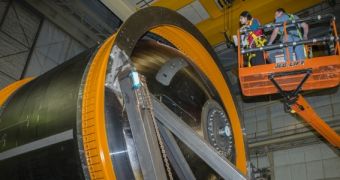The image above shows engineers from NASA and the Boeing Company working hard to prepare a new and advanced composite rocket propellant tank for testing at the space agency's Marshall Space Flight Center (MSFC) in Huntsville, Alabama. This innovative tank, which will hold cryogenic propellants, is a technology demonstrator for new capabilities the space agency is interested in.
The structure, which is one of the largest composite tanks ever assembled, was delivered to the MSFC aboard the NASA Supper Guppy wide-bodied aircraft in late March, and it has since been transferred to a dedicated testing area aboard a 96-wheeled truck called Kmag. The tank has the capacity to hold no less than 105,992 liters (28,000 gallons) of liquid hydrogen at extremely low, or cryogenic, temperatures.
After scientists at NASA and the Boeing Developmental Center in Tukwila, Washington, finish preparing the tank for testing, the entire structure will be cocooned in a special insulating material and then installed on its test stand. The experiments to be conducted at MSFC seek to determine how conditions during a potential launch would influence the tank. Deformations are the main concern here.
“This advanced composite cryotank could benefit many of NASA’s deep space exploration spacecraft including NASA's Space Launch System, the largest most powerful rocket ever built,” officials at the agency said in a statement released on Thursday, April 10.
“NASA focused on this technology because composite tanks promise a 30 percent weight reduction and a 25 percent cost savings over the best metal tanks used today,” the document concluded.

 14 DAY TRIAL //
14 DAY TRIAL //